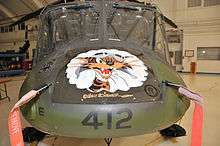438 Tactical Helicopter Squadron
| 438 Tactical Helicopter Squadron | |
|---|---|
|
438 Squadron badge | |
| Active | 1934–present |
| Country | Canada |
| Branch | Royal Canadian Air Force |
| Role | Tactical helicopter |
| Part of | 1 Wing |
| Home station | CFB Montreal |
| Nickname(s) | Wildcats |
| Motto(s) | Going down |
| Battle honours |
|
| Website |
rcaf-arc |
| Insignia | |
| Squadron Badge | The head of a wildcat affronte |
| Aircraft flown | |
| Helicopter | CH-146 Griffon |
438 "City of Montreal" Tactical Helicopter Squadron (French: 438e Escadron tactique d'hélicoptères) is a unit of the Royal Canadian Air Force. The squadron operates the CH-146 Griffon tactical helicopter from CFB St. Hubert in Quebec, Canada. Its tasks include transport, reconnaissance, search and rescue, and support to local law enforcement.
The motto Going Down was adopted during the Second World War when operating on Hawker Typhoons over occupied Europe. This was the flight leader's instruction to begin diving attacks with bombs, cannons or both.
History

Authorized at Montreal, Quebec, on September 1, 1934, as No.18 Squadron. It was renumbered No.118 Squadron on November 17, 1937. In its pre-war years, the unit flew the de Havilland DH.60 Moth.
A book was written and published on the history of the Squadron: Le 438e Escadron tactique d'hélicoptères 1934-2009 by Jerry Fielden and Michel Pratt was published in August 2010.
Second World War
Still then numbered as No. 118 (Fighter) Squadron, the unit moved to Dartmouth, Nova Scotia, in October 1939 as the only operational fighter squadron on the east coast of Canada. It began operations with the Westland Lysander but this aircraft was considered so lacking as a suitable fighter aircraft the squadron was disbanded in September 1940 and it was not stood up again until the unwanted Goblin fighter made its appearance. The fifteen CCF GE23 Goblin equipped the newly formed 118 Fighter Squadron in December 1940 which immediately moved the Goblins from working up in Rockcliffe to Dartmouth in order to continue the defence of Canada's east coast. The Goblins continued until replaced by the Curtis Kittyhawk in December, 1941. The squadron was sent to serve in the Alaska campaign and flew from Annette Island as part of Y Wing. On January 16, 1942, two squadron Kittyhawks spotted and attacked a surfaced German U-boat barely 10 miles from Halifax. F/O W.P. Roberts flying Kittyhawk AK851 was able to fire six bursts and obtain a number of hits around the conning tower. Embarking for Europe on November 2, 1943, the unit was renumbered No. 438 Squadron, and was part of 2TAF's 143 Wing RCAF.
The Squadron was so successful in the following exploit that the Squadron Leader was awarded the D.F.C.: The London Gazette of October 24, 1944, reported: No. 438 (R.C.A.F.) Sqn. In July 1944 Squadron Leader Beirnes led a formation of aircraft in an attack on a vital railway bridge over the river Orne just south of Caen. In spite of intense anti-aircraft fire and much low cloud the attack was pressed home and the bridge destroyed. In this well executed operation, Squadron Leader Beirnes displayed a high degree of skill, courage and leadership. In August, 1944, this officer again proved his skill when leading a formation in an attack against enemy mortar positions near the Forest of Grimbosq.
Hugh A. Halliday in his book [1] describes some later squadron actions in 1944: "September 10 produced four missions. At 1520 hours S/L Beirnes led nine Typhoons to the area of Turnhout-Venlo-Eindhoven to strafe four trains, each with 10-20 cars. In each case the locomotive was destroyed. The flight landed at 1630 and was off again at 1930, this time with 500-pounders to blast shipping at Hoedekenskerke. All bombs were on target, hitting either ships or docks. One ship, apparently carrying ammunition, blew up in spectacular fashion and another vessel was left smoking."
Aircraft operated:
- Blackburn Shark (October 1939–September 1940) – torpedo bomber
- Armstrong Whitworth Atlas (October 1939–September 1940) co-operation aircraft
- Westland Lysander (October 1939–September 1940) – co-operation and liaison aircraft
- Grumman Goblin (December 1940–November 1941) – naval fighter
- P-40 Kittyhawk MkI (December 1941–October 1943) – fighter
- Hawker Hurricane MkIV (November 1943–May 1944) – fighter
- Hawker Typhoon MkIB (January 1944–August 1945) – fighter bomber
Postwar
Aircraft operated:
- North American Harvard (November 1946–March 1948)
- de Havilland Vampire (April 1948–September 1954)
- Canadair T-33 Silver Star (November 1954–September 1958) – jet trainer
- Canadair Sabre (October 1956–November 1958) – fighter
- Beechcraft Expeditor (November 1958–March 1964) – trainer/utility aircraft
- CSR-123 Otter (September 1960 – 1982) – [radial engine – not turboprop] light utility transport
- CH-136 Kiowa (1982–1995) – observation helicopter
- CH-146 Griffon (1995 to present) – utility helicopter

External links
- Official website
- "438 Tactical Helicopter Squadron". Royal Canadian Air Force. 2013.
- "438 Tactical Helicopter Squadron". CMP Directorate of History and Heritage. 2013.
- "No. 438 Squadron". canadianwings.com. 2013.
- "438 Squadron Operations Record Book, June 1944". Juno Beach Centre. 2003.
References
- ↑ "Typhoon and Tempest
- Jerry Fielden et Michel Pratt, Le 438e Escadron 1934-2009. Éditions Histoire Québec, Collection Société historique du Marigot, 158 p.
- Typhoon and Tempest by Hugh A. Halliday
- The London Gazette
